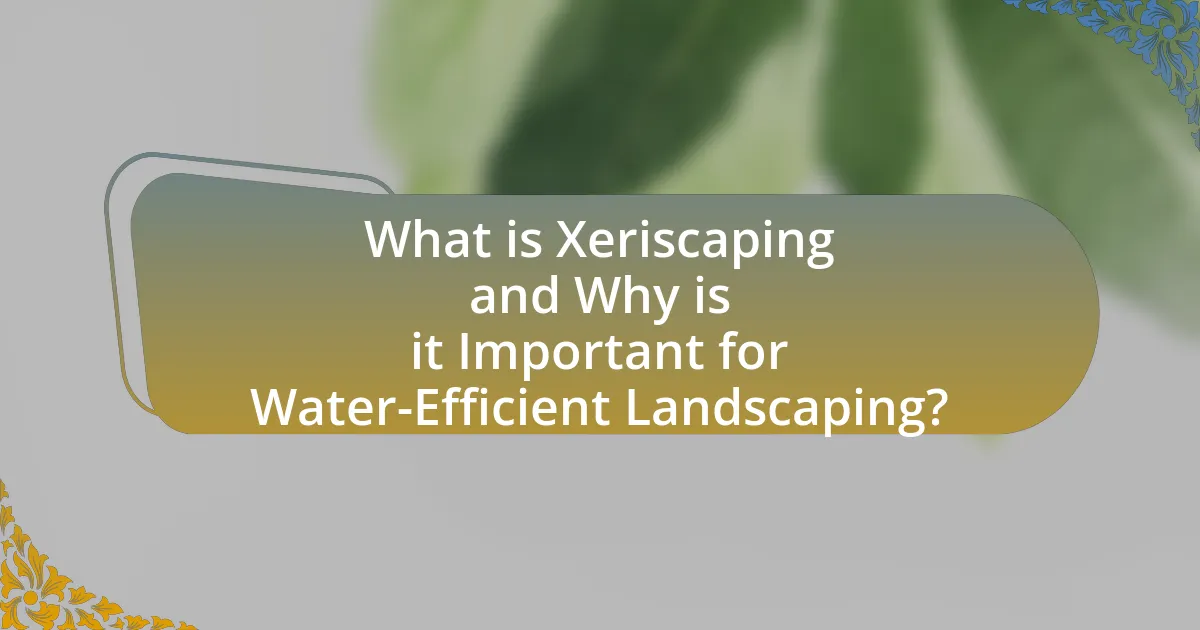Xeriscaping is a water-efficient landscaping method that reduces or eliminates the need for irrigation by utilizing drought-resistant plants and effective water management techniques. This approach is essential for conserving water resources, minimizing maintenance costs, and promoting sustainable gardening practices, particularly in regions facing water scarcity. The article outlines the key principles of xeriscaping, including planning, soil improvement, efficient irrigation, and plant selection, while also discussing the environmental benefits, challenges, and misconceptions associated with this landscaping method. Additionally, it provides practical tips for implementing xeriscaping effectively, adapting it to various climates and soil types, and resources for further learning.

What is Xeriscaping and Why is it Important for Water-Efficient Landscaping?
Xeriscaping is a landscaping method designed to reduce or eliminate the need for irrigation by using drought-resistant plants and efficient water management techniques. This approach is important for water-efficient landscaping because it conserves water resources, minimizes maintenance costs, and promotes sustainable gardening practices. According to the American Society of Landscape Architects, xeriscaping can reduce outdoor water use by up to 50%, making it a crucial strategy in regions facing water scarcity.
How does Xeriscaping differ from traditional landscaping?
Xeriscaping differs from traditional landscaping primarily in its focus on water conservation. While traditional landscaping often relies on high water usage for maintaining lush lawns and diverse plant species, xeriscaping emphasizes the use of drought-resistant plants and efficient irrigation techniques to minimize water consumption. Xeriscaping incorporates practices such as soil amendment, mulching, and strategic plant placement to create a sustainable landscape that thrives in arid conditions, reducing the need for supplemental watering. This approach is particularly beneficial in regions prone to drought, where water resources are limited, making xeriscaping a practical alternative to conventional landscaping methods.
What are the key principles of Xeriscaping?
The key principles of Xeriscaping include planning and design, soil improvement, efficient irrigation, plant selection, mulching, and maintenance. Planning and design involve creating a landscape that minimizes water use while maximizing aesthetic appeal. Soil improvement enhances water retention and drainage, making it easier for plants to thrive. Efficient irrigation techniques, such as drip systems, deliver water directly to the roots, reducing waste. Plant selection focuses on choosing drought-resistant species that require less water. Mulching helps retain soil moisture and suppress weeds. Finally, regular maintenance ensures that the landscape remains healthy and water-efficient. These principles collectively promote sustainable landscaping practices that conserve water resources.
How does climate influence Xeriscaping practices?
Climate significantly influences Xeriscaping practices by determining the types of plants that can thrive in a specific region and the irrigation methods that are most effective. In arid and semi-arid climates, Xeriscaping emphasizes drought-resistant plants that require minimal water, such as succulents and native species, which are adapted to survive with limited moisture. Additionally, climate conditions dictate the design elements of Xeriscaping, such as the use of mulch to retain soil moisture and the strategic placement of plants to maximize shade and minimize evaporation. Research indicates that regions with lower annual rainfall benefit from these practices, as they reduce water consumption by up to 50% compared to traditional landscaping methods.
What are the environmental benefits of Xeriscaping?
Xeriscaping provides significant environmental benefits, primarily by reducing water consumption and promoting biodiversity. This landscaping method utilizes drought-resistant plants, which require less irrigation, thereby conserving water resources. According to the U.S. Environmental Protection Agency, xeriscaping can reduce outdoor water use by up to 50% or more, depending on the region. Additionally, xeriscaping supports local wildlife by creating habitats for native species, enhancing ecosystem health. By minimizing the need for chemical fertilizers and pesticides, xeriscaping also reduces runoff pollution, contributing to cleaner waterways.
How does Xeriscaping contribute to water conservation?
Xeriscaping contributes to water conservation by utilizing drought-resistant plants and efficient landscaping techniques that minimize water usage. This approach reduces the need for irrigation, as native and adapted plants are selected for their ability to thrive in local climate conditions, often requiring significantly less water than traditional landscaping. Studies indicate that xeriscaping can reduce outdoor water use by up to 50% or more, depending on the region and plant selection, thereby conserving valuable water resources and promoting sustainable landscaping practices.
What impact does Xeriscaping have on local ecosystems?
Xeriscaping positively impacts local ecosystems by promoting biodiversity and reducing water consumption. This landscaping method utilizes drought-resistant plants that are native to the region, which supports local wildlife, including pollinators like bees and butterflies. Research indicates that areas designed with xeriscaping can sustain a greater variety of plant and animal species compared to traditional lawns, which often rely on high water usage and chemical fertilizers. Additionally, xeriscaping minimizes runoff and erosion, contributing to healthier soil and water quality in the surrounding environment.

How can Xeriscaping be implemented effectively?
Xeriscaping can be implemented effectively by following seven key principles: planning and design, soil improvement, appropriate plant selection, efficient irrigation, mulching, maintenance, and monitoring. Each principle contributes to creating a sustainable landscape that conserves water.
Planning and design involve assessing the site and creating a layout that groups plants with similar water needs. Soil improvement enhances water retention and drainage, making it easier for plants to thrive. Selecting drought-tolerant plants suited to the local climate reduces water usage significantly. Efficient irrigation techniques, such as drip systems, minimize waste by delivering water directly to the roots. Mulching helps retain soil moisture and suppress weeds, while regular maintenance ensures plants remain healthy and resilient. Finally, monitoring the landscape allows for adjustments based on plant performance and environmental changes.
Research indicates that implementing these principles can reduce landscape water use by up to 50%, demonstrating the effectiveness of xeriscaping in promoting water-efficient landscaping.
What steps are involved in creating a Xeriscape garden?
Creating a Xeriscape garden involves seven key steps: planning and design, soil preparation, selecting appropriate plants, grouping plants by water needs, implementing efficient irrigation, applying mulch, and maintaining the garden.
- Planning and design require assessing the site conditions, including sunlight, soil type, and existing vegetation, to create a layout that maximizes water efficiency.
- Soil preparation involves improving soil quality through amendments to enhance drainage and nutrient retention, which supports plant health.
- Selecting appropriate plants focuses on choosing drought-tolerant species native to the region, which are better adapted to local climate conditions.
- Grouping plants by water needs ensures that plants with similar irrigation requirements are placed together, optimizing water usage.
- Implementing efficient irrigation includes using drip systems or soaker hoses to minimize water waste and deliver moisture directly to the roots.
- Applying mulch helps retain soil moisture, suppress weeds, and regulate soil temperature, further reducing the need for irrigation.
- Maintaining the garden involves regular monitoring for pests, adjusting irrigation as needed, and replacing any dead plants to ensure long-term sustainability.
These steps collectively contribute to a water-efficient landscape that conserves resources while providing aesthetic and ecological benefits.
How do you select appropriate plants for Xeriscaping?
To select appropriate plants for Xeriscaping, prioritize native and drought-tolerant species that thrive in your local climate. These plants are adapted to the environmental conditions and require minimal irrigation once established. For example, in arid regions, succulents, ornamental grasses, and certain perennials like lavender and sage are excellent choices due to their low water needs and resilience. Research indicates that using native plants can reduce water usage by up to 50% compared to traditional landscaping, making them a sustainable option for Xeriscaping.
What role does soil preparation play in Xeriscaping?
Soil preparation is crucial in Xeriscaping as it enhances water retention and promotes healthy plant growth. Properly prepared soil improves drainage and aeration, which are essential for drought-resistant plants. Research indicates that incorporating organic matter into the soil can increase its water-holding capacity by up to 20%, thereby reducing the need for irrigation. This foundational step ensures that plants can thrive in arid conditions while minimizing water usage, aligning with the principles of Xeriscaping.
What maintenance practices are necessary for Xeriscaped landscapes?
Xeriscaped landscapes require specific maintenance practices to ensure their health and sustainability. Key practices include regular weeding to prevent competition for resources, periodic mulching to retain soil moisture and suppress weeds, and infrequent but deep watering to encourage deep root growth. Additionally, pruning of plants is necessary to promote healthy growth and remove dead or diseased material. Soil testing and amendment may also be required to maintain nutrient levels, ensuring that the plants thrive in their environment. These practices are essential for maintaining the efficiency and effectiveness of xeriscaping, which is designed to minimize water usage while maximizing landscape health.
How often should Xeriscaped areas be watered?
Xeriscaped areas should typically be watered once every two to three weeks, depending on local climate conditions and seasonal changes. This infrequent watering schedule is designed to promote deep root growth and drought resistance in plants, which is a fundamental principle of xeriscaping. Research indicates that xeriscaped landscapes can thrive with minimal water, as they are composed of drought-tolerant plants specifically selected for their low water needs.
What are the best practices for pruning and managing Xeriscaped plants?
The best practices for pruning and managing Xeriscaped plants include selective pruning, proper timing, and maintaining soil health. Selective pruning involves removing dead or diseased branches to promote healthy growth and improve air circulation, which is crucial for drought-tolerant plants. Proper timing, typically in late winter or early spring before new growth begins, ensures minimal stress on the plants. Additionally, maintaining soil health through mulching and organic amendments supports root development and moisture retention, which is essential for the survival of Xeriscaped plants in arid conditions. These practices enhance the resilience and aesthetic appeal of Xeriscaped landscapes while optimizing water efficiency.

What challenges might arise with Xeriscaping?
Xeriscaping can present several challenges, including initial costs, plant selection, and maintenance requirements. The initial costs can be higher due to the need for specialized plants and landscaping materials that are drought-resistant. Additionally, selecting appropriate plants that thrive in specific climates can be difficult, as not all native or drought-tolerant species will perform well in every environment. Maintenance can also be a challenge, as xeriscaped gardens may require specific care techniques, such as proper mulching and irrigation practices, to ensure plant health and sustainability. These factors can complicate the implementation and long-term success of xeriscaping projects.
What common misconceptions exist about Xeriscaping?
Common misconceptions about Xeriscaping include the belief that it results in a barren landscape and requires no maintenance. In reality, Xeriscaping promotes the use of drought-resistant plants that can create vibrant and diverse gardens while significantly reducing water usage. Additionally, while Xeriscaping minimizes water needs, it still requires regular maintenance, such as pruning and weeding, to keep the landscape healthy and attractive. Studies have shown that properly designed Xeriscaped areas can be just as lush and appealing as traditional landscapes, debunking the myth of a dry, lifeless garden.
How can homeowners overcome resistance to Xeriscaping?
Homeowners can overcome resistance to Xeriscaping by educating themselves and their communities about its benefits, such as reduced water usage and lower maintenance costs. Providing clear information on how Xeriscaping conserves water—up to 50% compared to traditional landscaping—can help dispel misconceptions. Additionally, showcasing successful local Xeriscaping projects can serve as tangible proof of its aesthetic appeal and practicality, encouraging others to adopt similar practices. Engaging with local gardening clubs or workshops can further facilitate discussions and foster acceptance of Xeriscaping as a viable landscaping option.
What are the potential drawbacks of Xeriscaping?
The potential drawbacks of Xeriscaping include limited plant diversity, which can lead to a less visually appealing landscape, and the initial costs associated with design and installation. Xeriscaping often relies on drought-resistant plants that may not provide the same aesthetic variety as traditional landscaping, potentially reducing the overall attractiveness of the property. Additionally, while Xeriscaping can save water in the long term, the upfront investment for soil amendments, irrigation systems, and native plants can be significant, sometimes deterring homeowners from adopting this approach.
How can Xeriscaping be adapted to different environments?
Xeriscaping can be adapted to different environments by selecting appropriate drought-resistant plants that thrive in specific local conditions, such as soil type, climate, and rainfall patterns. For instance, in arid regions, succulents and native grasses are effective, while in temperate climates, a mix of perennials and shrubs can be utilized. Additionally, implementing techniques like soil amendment to improve water retention and using mulch to reduce evaporation can enhance the effectiveness of xeriscaping across various environments. Research indicates that tailored plant selection and soil management can lead to a 50% reduction in water usage compared to traditional landscaping methods, demonstrating the adaptability and efficiency of xeriscaping practices.
What strategies can be used for Xeriscaping in urban areas?
Xeriscaping in urban areas can be effectively implemented through strategies such as selecting drought-resistant plants, utilizing efficient irrigation systems, and improving soil quality. Drought-resistant plants, such as succulents and native species, require less water and are well-suited for local climates, reducing overall water consumption. Efficient irrigation systems, including drip irrigation and smart controllers, minimize water waste by delivering water directly to the plant roots. Additionally, enhancing soil quality with organic matter improves water retention, allowing plants to thrive with less frequent watering. These strategies collectively contribute to sustainable landscaping practices that conserve water in urban environments.
How can Xeriscaping be tailored for different soil types?
Xeriscaping can be tailored for different soil types by selecting appropriate plants and modifying soil conditions to enhance water retention and drainage. For sandy soils, which drain quickly, incorporating organic matter can improve moisture retention, while choosing drought-resistant plants that thrive in such conditions is essential. In clay soils, which retain water, amending the soil with sand or compost can improve drainage, and selecting plants that tolerate wetter conditions will promote healthy growth. Research indicates that adapting xeriscaping techniques to specific soil types can significantly enhance landscape sustainability and water efficiency, as demonstrated in studies by the Colorado State University Extension, which emphasizes the importance of soil management in xeriscaping practices.
What are some practical tips for successful Xeriscaping?
Successful Xeriscaping involves selecting drought-resistant plants, grouping plants with similar water needs, and utilizing mulch to retain soil moisture. Choosing native or adapted plants minimizes water usage, as these species are better suited to local climates. Grouping plants according to their water requirements ensures efficient irrigation, reducing waste. Additionally, applying a layer of organic mulch around plants helps to conserve moisture, suppress weeds, and regulate soil temperature. Implementing these strategies can lead to a sustainable and low-maintenance landscape that significantly reduces water consumption.
How can homeowners start small with Xeriscaping projects?
Homeowners can start small with Xeriscaping projects by selecting a limited area of their yard to convert into a drought-resistant landscape. This approach allows them to gradually implement water-efficient practices, such as choosing native plants that require less water and grouping plants with similar water needs together. Research indicates that native plants can reduce water usage by up to 50% compared to traditional landscaping. Additionally, homeowners can incorporate mulch to retain soil moisture and minimize evaporation, further enhancing water efficiency. By beginning with a small section, homeowners can assess the effectiveness of their Xeriscaping efforts and expand as they gain experience.
What resources are available for learning more about Xeriscaping?
Resources for learning more about Xeriscaping include books, online courses, and local extension services. Notable books such as “Xeriscape Plant Guide” by the Denver Water Department provide comprehensive plant lists and design tips. Online platforms like the University of Arizona’s Cooperative Extension offer free courses and webinars focused on water-efficient landscaping techniques. Additionally, local extension services often provide workshops and resources tailored to specific regional climates and plant selections, enhancing practical knowledge in Xeriscaping.


